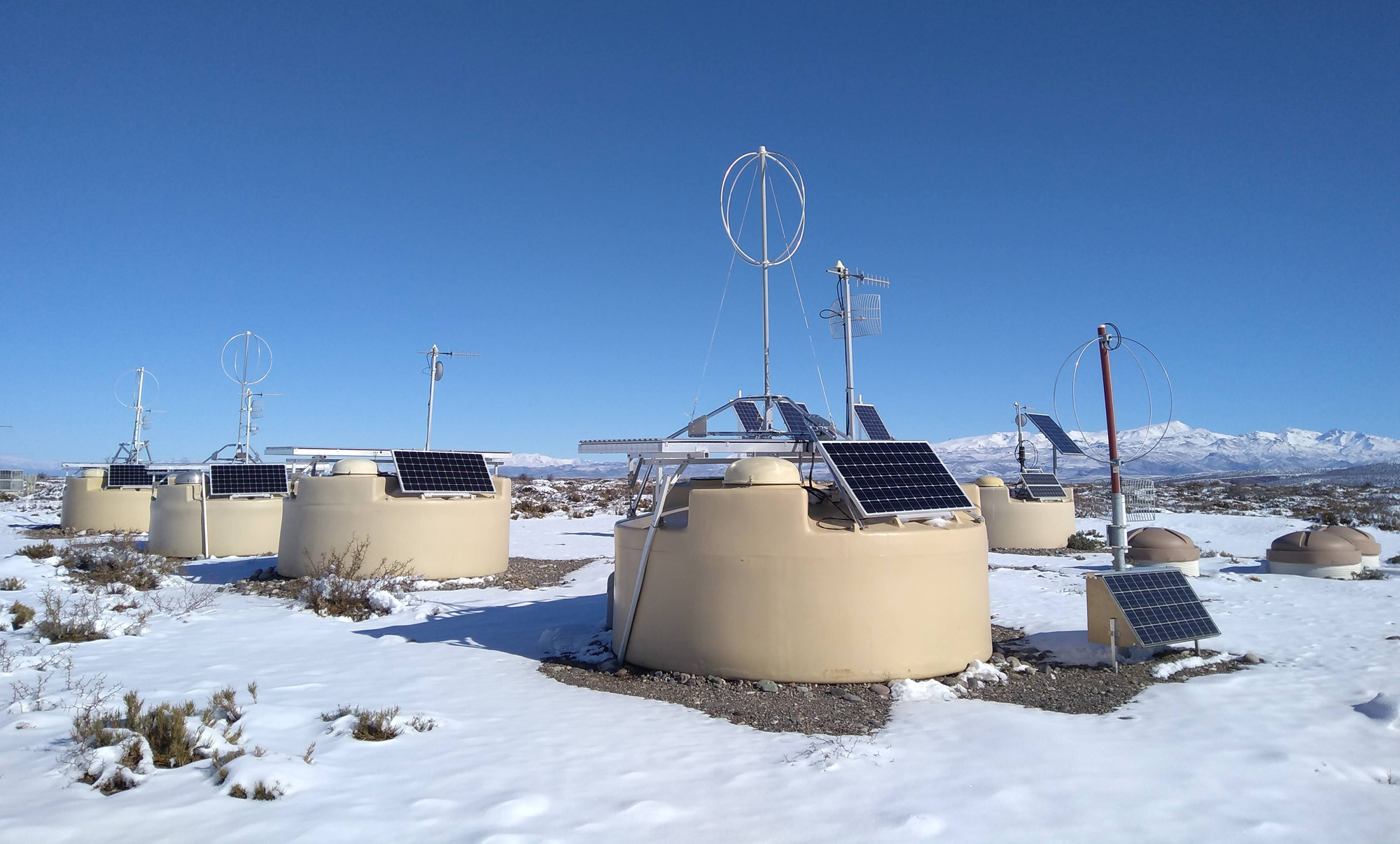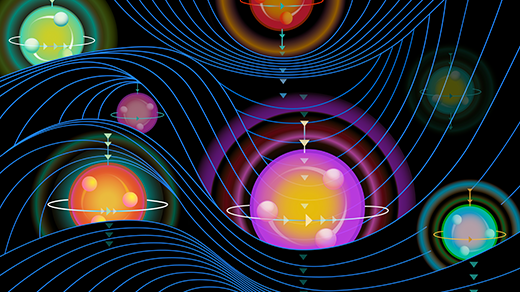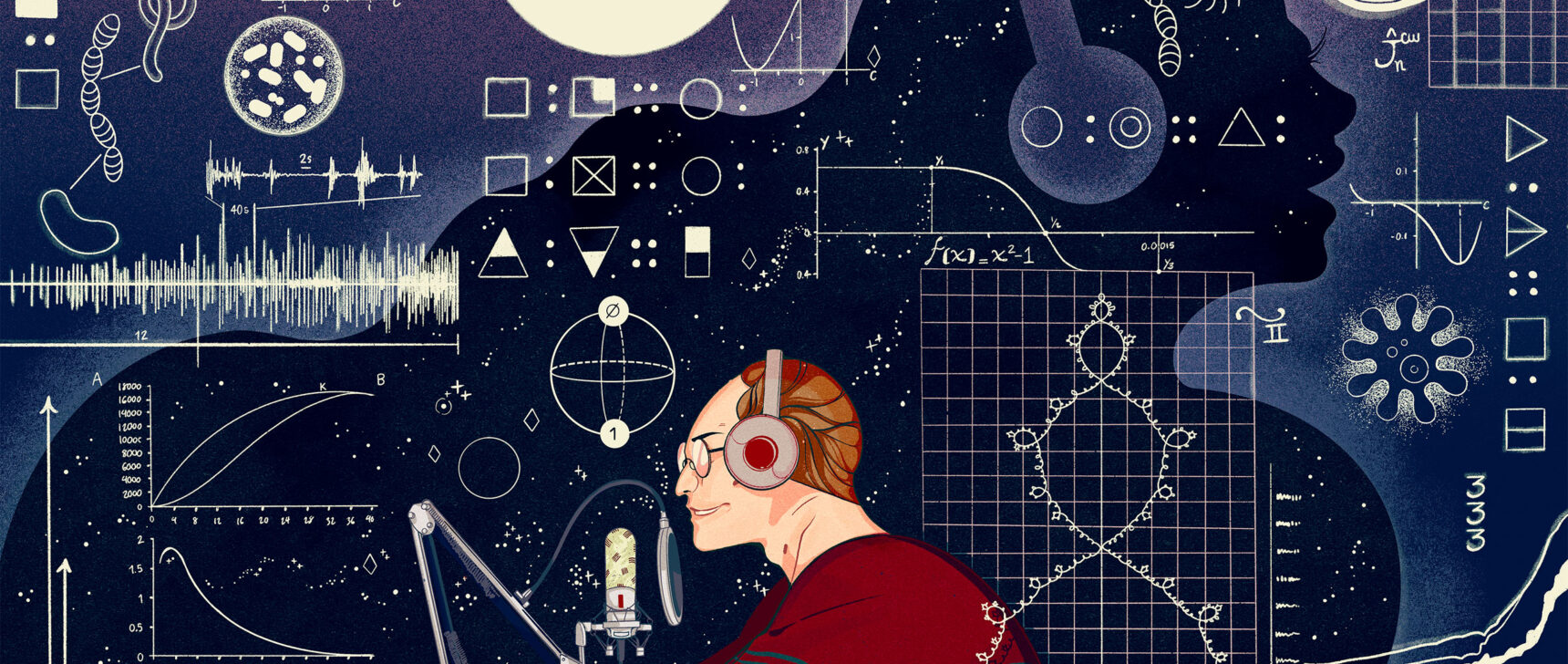Cosmic Map of Ultrahigh-Energy Particles Points to Long-Hidden Treasures

Starburst galaxies, active galactic nuclei and tidal disruption events (from left) have emerged as top candidates for the dominant source of ultrahigh-energy cosmic rays.
Daniel Chang for Quanta Magazine
Introduction
In the 1930s, the French physicist Pierre Auger placed Geiger counters along a ridge in the Alps and observed that they would sometimes spontaneously click at the same time, even when they were up to 300 meters apart. He knew that the coincident clicks came from cosmic rays, charged particles from space that bang into air molecules in the sky, triggering particle showers that rain down to the ground. But Auger realized that for cosmic rays to trigger the kind of enormous showers he was seeing, they must carry fantastical amounts of energy — so much that, he wrote in 1939, “it is actually impossible to imagine a single process able to give to a particle such an energy.”
Upon constructing larger arrays of Geiger counters and other kinds of detectors, physicists learned that cosmic rays reach energies at least 100,000 times higher than Auger supposed.
A cosmic ray is just an atomic nucleus — a proton or a cluster of protons and neutrons. Yet the rare ones known as “ultrahigh-energy” cosmic rays have as much energy as professionally served tennis balls. They’re millions of times more energetic than the protons that hurtle around the circular tunnel of the Large Hadron Collider in Europe at 99.9999991% of the speed of light. In fact, the most energetic cosmic ray ever detected, nicknamed the “Oh-My-God particle,” struck the sky in 1991 going something like 99.99999999999999999999951% of the speed of light, giving it roughly the energy of a bowling ball dropped from shoulder height onto a toe. “You would have to build a collider as large as the orbit of the planet Mercury to accelerate protons to the energies we see,” said Ralph Engel, an astrophysicist at the Karlsruhe Institute of Technology in Germany and the co-leader of the world’s largest cosmic-ray observatory, the Pierre Auger Observatory in Argentina.
The question is: What’s out there in space doing the accelerating?
Supernova explosions are now thought to be capable of producing the astonishingly energetic cosmic rays that Auger first observed 82 years ago. Supernovas can’t possibly yield the far more astonishing particles that have been seen since. The origins of these ultrahigh-energy cosmic rays remain uncertain. But a series of recent advances has significantly narrowed the search.
In 2017, the Auger Observatory announced a major discovery. With its 1,600 particle detectors and 27 telescopes dotting a patch of Argentinian prairie the size of Rhode Island, the observatory had recorded the air showers of hundreds of thousands of ultrahigh-energy cosmic rays over the previous 13 years. The team reported that 6% more of the rays come from one half of the sky than the other — the first pattern ever definitively detected in the arrival directions of cosmic rays.

The Pierre Auger Observatory in Argentina consists of an array of 1,600 detectors such as these. When a cosmic ray strikes the sky, a shower of secondary charged particles rains down. These particles create flashes of radiation as they traverse the water inside the detectors, collectively revealing the energy and direction of the incoming cosmic ray.
Recently, three theorists at New York University offered an elegant explanation for the imbalance that experts see as highly convincing. The new paper, by Chen Ding, Noémie Globus and Glennys Farrar, implies that ultrapowerful cosmic-ray accelerators are ubiquitous, cosmically speaking, rather than rare.
The Auger Observatory and the Telescope Array in Utah have also detected smaller, subtler cosmic ray “hot spots” in the sky — presumably the locations of nearby sources. Certain candidate objects sit at the right locations.
More clues have arrived in the form of super-energetic neutrinos, which are produced by ultrahigh-energy cosmic rays. Collectively, the recent discoveries have focused the search for the universe’s ultrapowerful accelerators on three main contenders. Now, theorists are busy modeling these astrophysical objects to see whether they’re indeed capable of flinging fast-enough particles toward us, and if so, how.
These speculations are brand new and unconstrained by any data. “If you go to high energies, things are really unexplored,” Engel said. “You really go somewhere where everything is blank.”
A Fine Imbalance
To know what’s making ultrahigh-energy cosmic rays, step one is to see where they’re coming from. The trouble is that, because the particles are electrically charged, they don’t travel here in straight lines; their paths bend as they pass through magnetic fields.
Moreover, the ultrahigh-energy particles are rare, striking each square kilometer of Earth’s sky only about once per year. Identifying any pattern in their arrival directions requires teasing out subtle statistical imbalances from a huge data set.
No one knew how much data would be needed before patterns would emerge. Physicists spent decades building ever-larger arrays of detectors without seeing even a hint of a pattern. Then in the early 1990s, the Scottish astrophysicist Alan Watson and the American physicist Jim Cronin decided to go really big. They embarked on what would become the 3,000-square-kilometer Auger Observatory.
Finally, that was enough. When the Auger team reported in Science in 2017 that it had detected a 6% imbalance between two halves of the sky — where an excess of particles from one particular direction in the sky smoothly transitioned into a deficit centered in the opposite direction — “that was fantastically exciting,” said Watson. “I’ve worked in this field for a very, very long time” — since the 1960s — “and this is the first time we’ve had an anisotropy.”
Samuel Velasco/Quanta Magazine; Source: arxiv.org/pdf/2101.04564
But the data was also puzzling. The direction of the cosmic-ray excess was nowhere near the center of the Milky Way galaxy, supporting the long-standing hypothesis that ultrahigh-energy cosmic rays come from outside the galaxy. But it was nowhere near anything. It didn’t correspond to the location of some powerful astrophysical object like a supermassive black hole in a neighboring galaxy. It wasn’t the Virgo cluster, the dense nearby concentration of galaxies. It was just a dull, dark spot near the constellation Canis Major.
Noémie Globus, then a postdoc at the Hebrew University of Jerusalem, immediately saw a way to explain the pattern. She began by making a simplification: that every bit of matter in the universe has equal probability of producing some small number of ultrahigh-energy cosmic rays. She then mapped out how those cosmic rays would bend slightly as they emanate from nearby galaxies, galaxy groups and clusters — collectively known as the large-scale structure of the cosmos — and travel here through the weak magnetic fields of intergalactic space. Naturally, her pretend map was just a blurry picture of the large-scale structure itself, with the highest concentration of cosmic rays coming from Virgo.
Her cosmic-ray excess wasn’t in the right spot to explain Auger’s data, but she thought she knew why: because she hadn’t adequately accounted for the magnetic field of the Milky Way. In 2019, Globus moved to NYU to work with the astrophysicist Glennys Farrar, whose 2012 model of the Milky Way’s magnetic field, developed with her then-graduate student Ronnie Jansson, remains state of the art. Although no one yet understands why the galaxy’s magnetic field is shaped the way it is, Farrar and Jansson inferred its geometry from 40,000 measurements of polarized light. They ascertained that magnetic field lines arc both clockwise and counterclockwise along the spiral arms of the galaxy and emanate vertically from the galactic disk, twisting as they rise.
Farrar’s graduate student Chen Ding wrote code that refined Globus’ map of ultrahigh-energy cosmic rays coming from the large-scale structure, then passed this input through the distorting lens of the galactic magnetic field as modeled by Farrar and Jansson. “And lo and behold we get this remarkable agreement with the observations,” Farrar said.
Virgo-originating cosmic rays bend around in the galaxy’s twisting field lines so that they strike us from the direction of Canis Major, where Auger sees the center of its excess. The researchers analyzed how the resulting pattern would change for cosmic rays of different energies. They consistently found a close match with different subsets of Auger’s data.
The researchers’ “continuous model” of the origins of ultrahigh-energy cosmic rays is a simplification — every piece of matter does not emit ultrahigh-energy cosmic rays. But its striking success reveals that the actual sources of the rays are abundant and spread evenly throughout all matter, tracing the large-scale structure. The study, which will appear in The Astrophysical Journal Letters, has garnered widespread praise. “This is really a fantastic step,” Watson said.
Immediately, certain stocks have risen: in particular, three types of candidate objects that thread the needle of being relatively common in the cosmos yet potentially special enough to yield Oh-My-God particles.
Icarus Stars
In 2008, Farrar and a co-author proposed that cataclysms called tidal disruption events (TDEs) might be the source of ultrahigh-energy cosmic rays.
A TDE occurs when a star pulls an Icarus and gets too close to a supermassive black hole. The star’s front feels so much more gravity than its back that the star gets ripped to smithereens and swirls into the abyss. The swirling lasts about a year. While it lasts, two jets of material — the subatomic shreds of the disrupted star — shoot out from the black hole in opposite directions. Shock waves and magnetic fields in these beams might then conspire to accelerate nuclei to ultrahigh energies before slingshotting them into space.
Tidal disruption events occur roughly once every 100,000 years in every galaxy, which is the cosmological equivalent of happening everywhere all the time. Since galaxies trace the matter distribution, TDEs could explain the success of Ding, Globus and Farrar’s continuous model.
Moreover, the relatively brief flash of a TDE solves other puzzles. By the time a TDE’s cosmic ray reaches us, the TDE will have been dark for thousands of years. Other cosmic rays from the same TDE might take separate bent paths; some might not arrive for centuries. The transient nature of a TDE could explain why there seems to be so little pattern to cosmic rays’ arrival directions, with no strong correlations with the positions of known objects. “I’m inclined now to believe they are transients, mostly,” Farrar said of the rays’ origins.
The TDE hypothesis got another boost recently, from an observation reported in Nature Astronomy in February.
Robert Stein, one of the paper’s authors, was operating a telescope in California called the Zwicky Transient Factory in October 2019 when an alert came in from the IceCube neutrino observatory in Antarctica. IceCube had spotted a particularly energetic neutrino. High-energy neutrinos are produced when even-higher-energy cosmic rays scatter off light or matter in the environment where they’re created. Luckily, the neutrinos, being neutral, travel to us in straight lines, so they point directly back to the source of their parent cosmic ray.
Stein swiveled the telescope in the arrival direction of IceCube’s neutrino. “We immediately saw there was a tidal disruption event from the position that the neutrino had arrived from,” he said.
The correspondence makes it more likely that TDEs are at least one source of ultrahigh-energy cosmic rays. However, the neutrino’s energy was probably too low to prove that TDEs produce the very highest-energy rays. Some researchers strongly question whether these transients can accelerate nuclei to the extreme end of the observed energy spectrum; theorists are still exploring how the events might accelerate particles in the first place.
Meanwhile, other facts have turned some researchers’ attention elsewhere.
Starburst Superwinds
Cosmic-ray observatories such as Auger and the Telescope Array have also found a few hot spots — small, subtle concentrations in the arrival directions of the very highest-energy cosmic rays. In 2018, Auger published the results of a comparison of its hot spots to the locations of astrophysical objects within a few hundred million light-years of here. (Cosmic rays from farther away would lose too much energy in mid-journey collisions.)
In the cross-correlation contest, no type of object performed exceptionally well — understandably, given the deflection cosmic rays experience. But the strongest correlation surprised many experts: About 10% of the rays came from within 13 degrees of the directions of so-called “starburst galaxies.” “They were not on my plate originally,” said Michael Unger of the Karlsruhe Institute of Technology, a member of the Auger team.
No one was more thrilled than Luis Anchordoqui, an astrophysicist at Lehman College of the City University of New York, who proposed starburst galaxies as the origin of ultrahigh-energy cosmic rays in 1999. “I can be kind of biased on these things because I was the one proposing the model that now the data is pointing to,” he said.
Starburst galaxies constantly manufacture a lot of huge stars. The massive stars live fast and die young in supernova explosions, and Anchordoqui argues that the “superwind” formed by the collective shock waves of all the supernovas is what accelerates cosmic rays to the mind-boggling speeds that we detect.
Not everyone is sure that this mechanism would work. “The question is: How fast are those shocks?” said Frank Rieger, an astrophysicist at Heidelberg University. “Should I expect those to go to the highest energies? At the moment I am doubtful about it.”
Other researchers argue that objects inside starburst galaxies might be acting as cosmic-ray accelerators, and that the cross-correlation study is simply picking up on an abundance of these other objects. “As a person who thinks of transient events as a natural source, those are very enriched in starburst galaxies, so I have no trouble,” said Farrar.
Active Galaxies
In the cross-correlation study, another kind of object performed almost but not quite as well as starburst galaxies: objects called active galactic nuclei, or AGNs.
AGNs are the white-hot centers of “active” galaxies, in which plasma engulfs the central supermassive black hole. The black hole sucks the plasma in while shooting out enormous, long-lasting jets.
The high-power members of an especially bright subset called “radio-loud” AGNs are the most luminous persistent objects in the universe, so they’ve long been leading candidates for the source of ultrahigh-energy cosmic rays.
However, these powerful radio-loud AGNs are too rare in the cosmos to pass the Ding, Globus and Farrar test: They couldn’t possibly be tracers for the large-scale structure. In fact, within our cosmic neighborhood, there are almost none. “They’re nice sources but not in our backyard,” Rieger said.
Less powerful radio-loud AGNs are much more common and could potentially resemble the continuous model. Centaurus A, for instance, the nearest radio-loud AGN, sits right at the Auger Observatory’s most prominent hot spot. (So does a starburst galaxy.)
For a long time Rieger and other specialists seriously struggled to get low-power AGNs to accelerate protons to Oh-My-God-particle levels. But a recent finding has brought them “back in the game,” he said.
Astrophysicists have long known that about 90% of all cosmic rays are protons (that is, hydrogen nuclei); another 9% are helium nuclei. The rays can be heavier nuclei such as oxygen or even iron, but experts long assumed that these would get ripped apart by the violent processes needed to accelerate ultrahigh-energy cosmic rays.
Then, in surprising findings in the early 2010s, Auger Observatory scientists inferred from the shapes of the air showers that ultrahigh-energy rays are mostly middleweight nuclei, such as carbon, nitrogen and silicon. These nuclei will achieve the same energy as protons while traveling at lower speeds. And that, in turn, makes it easier to imagine how any of the candidate cosmic accelerators might work.
For example, Rieger has identified a mechanism that would allow low-power AGNs to accelerate heavier cosmic rays to ultrahigh energies: A particle could drift from side to side in an AGN’s jet, getting kicked each time it reenters the fastest part of the flow. “In that case they find they can do that with the low-power radio sources,” Rieger said. “Those would be much more in our backyard.”
Another paper explored whether tidal disruption events would naturally produce middleweight nuclei. “The answer is that it could happen if the stars that are disrupted are white dwarfs,” said Cecilia Lunardini, an astrophysicist at Arizona State University who co-authored the paper. “White dwarfs have this sort of composition — carbon, nitrogen.” Of course, TDEs can happen to any “unfortunate star,” Lunardini said. “But there are lots of white dwarfs, so I don’t see this as something very contrived.”
Researchers continue to explore the implications of the highest-energy cosmic rays being on the heavy side. But they can agree that it makes the problem of how to accelerate them easier. “The heavy composition towards higher energy relaxes things much more,” Rieger said.
Primary Source
As the short list of candidate accelerators crystallizes, the search for the right answer will continue to be led by new observations. Everyone is excited for AugerPrime, an upgraded observatory; starting later this year, it will identify the composition of each individual cosmic ray event, rather than estimating the overall composition. That way, researchers can isolate the protons, which deflect the least on their way to Earth, and look back at their arrival directions to identify individual sources. (These sources would presumably produce the heavier nuclei as well.)
Many experts suspect that a mix of sources might contribute to the ultrahigh-energy cosmic-ray spectrum. But they generally expect one source type to dominate, and only one to reach the extreme end of the spectrum. “My money is on that it’s only one,” said Unger.
Editor’s note: Noémie Globus is currently affiliated with ELI Beamlines in the Czech Republic and the Flatiron Institute in New York. The Flatiron Institute is funded by the Simons Foundation, which also funds this editorially independent magazine. Affiliation with the Simons Foundation has no bearing on our coverage.
This article was reprinted on Wired.com.



